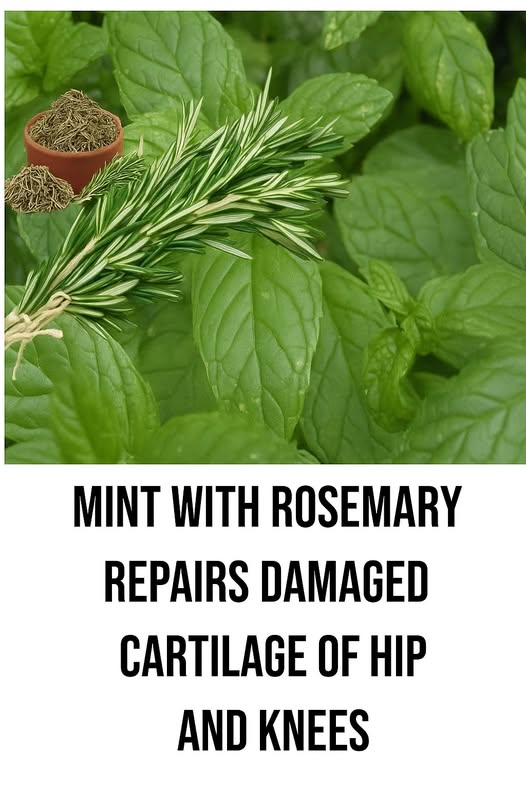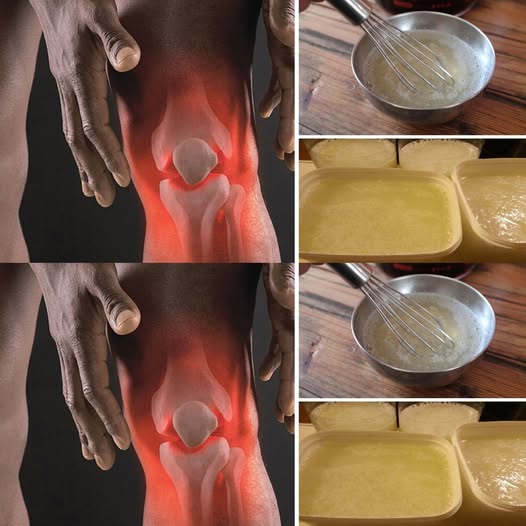Introduction
Hip and knee pain caused by cartilage damage is a growing concern, affecting millions of people worldwide. According to the World Health Organization (WHO), osteoarthritis—a condition often linked to cartilage degeneration—affects more than 528 million people globally. The pain, stiffness, and limited mobility that result from damaged cartilage can be debilitating, often leading to expensive treatments or even joint replacement surgeries.
But what if nature already provided a simple, powerful remedy hidden in your kitchen or garden? Recent research and traditional healing practices point to a remarkable combination: mint and rosemary. These two herbs, widely recognized for their culinary uses, also harbor anti-inflammatory, antioxidant, and cartilage-protective properties that may help restore joint health.
In this article, we’ll explore how mint with rosemary can support cartilage repair in the hips and knees, why this duo is gaining popularity in natural health circles, and how you can incorporate them into your daily routine for stronger, pain-free joints.
Why Cartilage Damage Matters
Cartilage is a smooth, rubbery tissue that cushions bones at the joints. Unlike other tissues in the body, cartilage has a very limited ability to heal because it lacks blood vessels. Once damaged, it often leads to chronic pain and stiffness.
The main causes of cartilage damage include:
- Aging – Natural wear and tear over time.
- Injuries – Sports or accidents that stress the joints.
- Obesity – Excess weight adds pressure to hips and knees.
- Inflammation – Chronic conditions such as arthritis accelerate cartilage breakdown.
Without proper care, damaged cartilage can progress into severe osteoarthritis, which often requires joint replacement surgery. That’s why finding natural ways to support cartilage health is vital.
Mint and Rosemary: Nature’s Joint-Healing Powerhouses
1. Mint for Joint Support
Mint isn’t just refreshing in teas and desserts—it’s a medicinal herb packed with therapeutic benefits.
- Anti-inflammatory effects: Mint contains rosmarinic acid and menthol, compounds known to reduce joint inflammation and stiffness.
- Pain relief: Studies show mint extracts can provide a natural analgesic effect, reducing pain without the side effects of synthetic drugs.
- Antioxidant power: The antioxidants in mint protect cartilage cells from free radical damage, slowing down cartilage wear.
2. Rosemary for Cartilage Repair
Rosemary, a staple in Mediterranean diets, is equally powerful when it comes to joint health.
- Boosts circulation: Better blood flow delivers nutrients that cartilage needs to regenerate.
- Protects cartilage cells: Rich in carnosic acid and rosmarinol, rosemary helps preserve cartilage structure.
- Reduces inflammation: Its strong anti-inflammatory properties help reduce swelling in the hips and knees.
- Enhances mobility: Regular use has been linked with improved flexibility and reduced stiffness.
How Mint and Rosemary Work Together for Cartilage Restoration
The real magic happens when mint and rosemary are combined. Their bioactive compounds work synergistically to:
- Reduce joint inflammation – calming swelling and pain.
- Protect cartilage cells – slowing down the degenerative process.
- Enhance nutrient absorption – supporting the rebuilding of joint tissues.
- Improve mobility – making daily movement easier and less painful.
This natural duo acts as both a preventive solution and a supportive remedy for those already struggling with hip and knee pain.
How to Use Mint and Rosemary for Joint Health
1. Herbal Tea
- Boil 2 cups of water.
- Add 1 teaspoon of dried rosemary and 1 teaspoon of dried mint.
- Steep for 10 minutes, strain, and enjoy twice daily.
2. Essential Oil Massage
- Mix 3 drops of rosemary essential oil and 3 drops of peppermint oil with 2 tablespoons of olive oil.
- Massage gently onto the affected hips or knees to relieve stiffness and improve circulation.
3. Infused Water
- Add fresh mint leaves and a sprig of rosemary to a glass of water.
- Let it infuse for a few hours and drink throughout the day for hydration and joint support.
4. Culinary Uses
- Add rosemary and mint to soups, stews, and roasted vegetables.
- Use them as marinades for meat or fish to enhance flavor and health benefits.
Frequently Asked Questions (FAQs)
1. Can mint and rosemary really rebuild cartilage?
While cartilage has limited self-repair ability, mint and rosemary provide compounds that support cartilage preservation, reduce inflammation, and improve mobility. They may not “rebuild” cartilage completely but can significantly slow degeneration and enhance joint function.
2. How long does it take to see results?
Natural remedies work gradually. Most people report noticeable relief in 4–8 weeks of consistent use. However, results vary depending on the severity of damage and lifestyle factors.
3. Are there any side effects?
Both mint and rosemary are generally safe when consumed in moderate amounts. However:
- Excessive rosemary may affect blood pressure.
- Mint in large quantities may cause acid reflux.
Always consult a healthcare provider before starting any new regimen, especially if you’re on medication.
4. Can I use this remedy alongside prescription medication?
Yes, in most cases. Mint and rosemary are safe to use with standard arthritis or pain medications, but always check with your doctor to avoid interactions.
5. Who should avoid using rosemary and mint?
- Pregnant women (especially rosemary in high amounts).
- People with bleeding disorders or taking blood thinners.
- Those with severe GERD or reflux issues (mint can worsen symptoms).
Scientific Backing: What Studies Say
- A 2015 study published in the Journal of Inflammation found that rosmarinic acid (from mint and rosemary) reduces cartilage inflammation in arthritis models.
- A 2020 clinical review showed rosemary extract improved knee pain and stiffness in osteoarthritis patients.
- Mint essential oil has been used in traditional medicine for centuries for pain relief and improving joint mobility.
These findings support the growing belief that combining mint and rosemary can be a natural, science-backed solution for joint care.
Lifestyle Strategies to Boost Cartilage Health
While mint and rosemary can help, a holistic approach maximizes results. Here are 5 proven strategies to protect and restore your joints:
- Maintain a Healthy Weight – Every extra pound adds stress to your hips and knees. Losing just 10 pounds can reduce knee pain by 20%.
- Stay Active – Low-impact exercises like swimming, yoga, and cycling improve mobility without stressing joints.
- Eat a Joint-Friendly Diet – Include omega-3-rich foods (salmon, walnuts), vitamin C (oranges, bell peppers), and collagen-boosting bone broth.
- Stay Hydrated – Cartilage is 70–80% water, so dehydration accelerates wear.
- Avoid Overuse – Give your joints rest and avoid repetitive stress movements.
Key Takeaways
- Mint and rosemary are more than kitchen herbs—they’re natural allies for joint health.
- They reduce inflammation, protect cartilage, and improve mobility in the hips and knees.
- Easy to use daily in teas, oils, infused water, or meals.
- Supported by scientific evidence and traditional healing wisdom.
- Best results come from combining this remedy with a healthy lifestyle.
Conclusion
Damaged cartilage in the hips and knees doesn’t have to dictate your quality of life. While conventional medicine often focuses on symptom management, nature offers powerful solutions that address the root causes of cartilage wear. The combination of mint and rosemary is emerging as a promising, science-backed, and easily accessible remedy for joint pain and cartilage support.
By incorporating these herbs into your daily routine—whether as tea, oil, or part of your diet—you can take proactive steps toward restoring mobility, reducing pain, and reclaiming an active lifestyle.
The best part? You don’t have to wait for years of research or expensive treatments. The solution may already be growing in your garden, ready to help you move with strength, comfort, and confidence once again.



